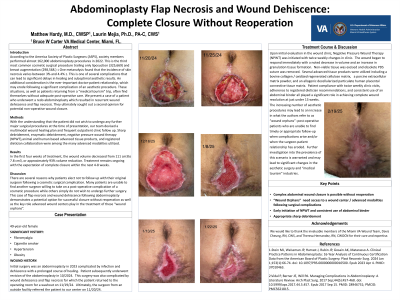Case Series/Study
(CS-062) Abdominoplasty Flap Necrosis and Wound Dehiscence: Complete Closure Without Reoperation

According to the America Society of Plastic Surgeons (ASPS), society members performed almost 162,000 abdominoplasty procedures in 2022. This is the third most common cosmetic surgical procedure trailing only liposuction (325,669) and breast augmentation (298,568.)1 One metanalysis found that the incidence of skin necrosis varies between 3% and 4.4%2. This is one of several complications that can lead to significant delays in healing and suboptimal aesthetic results. An additional consideration is the ever-important doctor-patient relationship, which may erode following a significant complication of an aesthetic procedure. These situations, as well as patients returning from a “medical tourism” trip, often find themselves without adequate post-operative care. We present a case of a patient who underwent a redo abdominoplasty which resulted in recurrent wound dehiscence and flap necrosis. They ultimately sought out a second opinion for potential non-operative wound closure.
Methods:
With the understanding that the patient did not wish to undergo any further major surgical procedures at the time of presentation, our team devised a multimodal wound healing plan and frequent outpatient clinic follow up. Sharp debridement, enzymatic debridement, negative pressure wound therapy (NPWT), animal and human based advanced tissue products, and registered dietician collaboration were among the many advanced modalities utilized.
Results:
In the first four weeks of treatment, the wound volume decreased from 111 cm3 to 7.8 cm3, or approximately 93% volume reduction. Treatment remains ongoing with the expectation of complete closure within the next 4-8 weeks.
Discussion:
There are several reasons why patients elect not to follow up with their original surgeon following a cosmetic surgical complication. Many patients are unable to find another surgeon willing to take on a post-operative complication of a cosmetic procedure while others simply do not wish to undergo further surgery. This case of flap necrosis and wound dehiscence following abdominoplasty demonstrates a potential option for successful closure without reoperation as well as the key role advanced wound centers play in the treatment of these “wound orphans”.

.jpg)